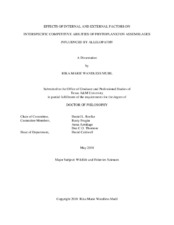| dc.contributor.advisor | Roelke, Daniel L | |
| dc.creator | Muhl, Rika Marie Wandless | |
| dc.date.accessioned | 2019-01-17T19:21:52Z | |
| dc.date.available | 2019-01-17T19:21:52Z | |
| dc.date.created | 2018-05 | |
| dc.date.issued | 2018-05-09 | |
| dc.date.submitted | May 2018 | |
| dc.identifier.uri | https://hdl.handle.net/1969.1/173560 | |
| dc.description.abstract | Phytoplankton allelopathic processes operate on short time scales, and some allelopathic species can alter phytoplankton succession and affect biodiversity. Both internal and external factors have a role in these processes.
Succession under allelopathic influence often results in dominance of the allelopathic species, and this research shows that how quickly an assemblage transitions from the effects of interference competition to exploitative competition is influenced by the similarity of life history traits of phytoplankton in an assemblage.
Ecologists accept that competition is invoked as resources become limiting; however, when co-occurring species are competitively similar, competition effects may be reduced. Using a mathematical model of phytoplankton competing for limiting resources for three types of assemblages, I found that intransitive assemblages yield the highest relative biodiversity, followed by lumpy assemblages, and neutral assemblages the lowest biodiversity. Testing these modelling results with empirical data from eight freshwater systems supports the idea that assemblages characterized by lumpiness are more resistant to blooms of allelopathic species than assemblages that are not as lumpy.
Field experiments manipulating toxicity of the allelopathic phytoplankter Prymnesium parvum using different pH levels demonstrate the significance of biologic controls on the bloom potential of allelopathic species. Treatments with large zooplankton suppressed the population density of this haptophyte in waters from Galveston and Matagorda Bays.
These results may aid our understanding of broad themes in harmful algae ecology, including how ecosystems respond to disturbances such as allelopathy. | en |
| dc.format.mimetype | application/pdf | |
| dc.language.iso | en | |
| dc.subject | Phytoplankton | en |
| dc.subject | neutrality | en |
| dc.subject | lumpy | en |
| dc.subject | intransitive | en |
| dc.subject | exploitative competition | en |
| dc.subject | interference competition | en |
| dc.subject | allelopathy | en |
| dc.title | Effects of Internal and External Factors on Interspecific Competitive Abilities of Phytoplankton Assemblages Influenced by Allelopathy | en |
| dc.type | Thesis | en |
| thesis.degree.department | Wildlife and Fisheries Sciences | en |
| thesis.degree.discipline | Wildlife and Fisheries Sciences | en |
| thesis.degree.grantor | Texas A & M University | en |
| thesis.degree.name | Doctor of Philosophy | en |
| thesis.degree.level | Doctoral | en |
| dc.contributor.committeeMember | Feagin, Rusty | |
| dc.contributor.committeeMember | Armitage, Anna | |
| dc.contributor.committeeMember | Thornton, Dan CO | |
| dc.type.material | text | en |
| dc.date.updated | 2019-01-17T19:21:52Z | |
| local.etdauthor.orcid | 0000-0002-8249-6227 | |


